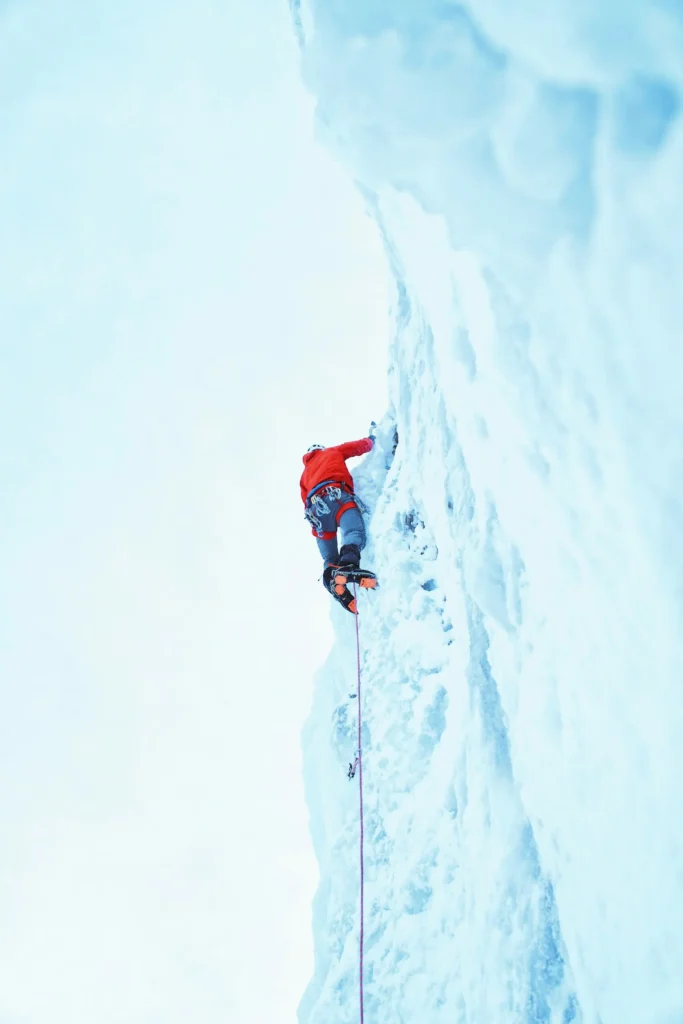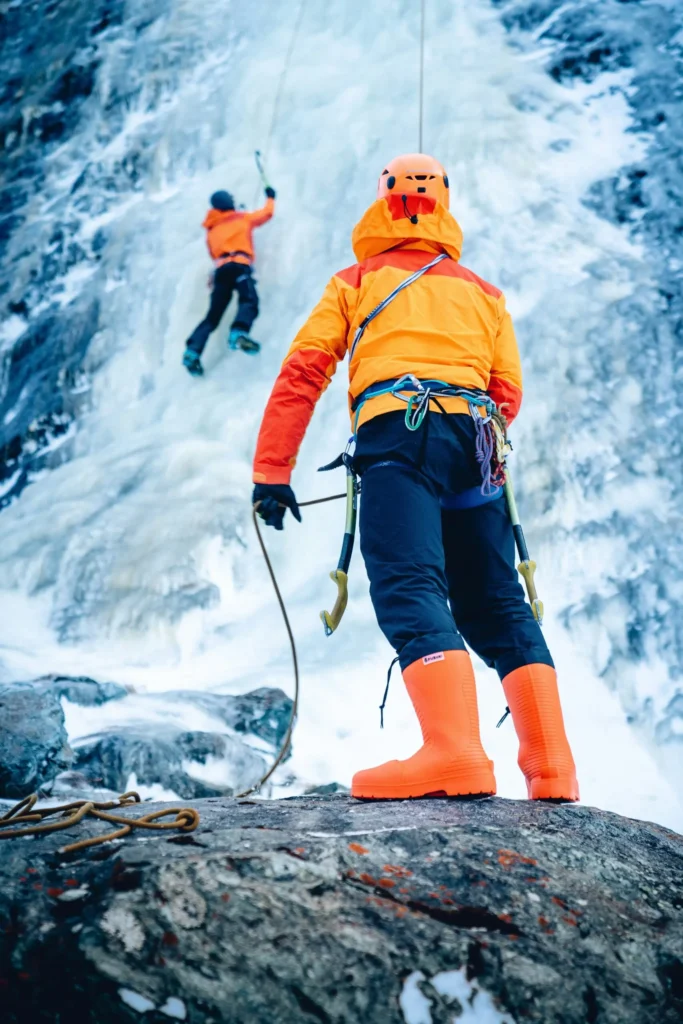Introduction:
Have you ever dreamed of conquering frozen waterfalls or scaling icy mountain faces? 🧊⛰️ Ice climbing is an exhilarating sport that combines the thrill of rock climbing with the unique challenges of winter environments. But for many aspiring climbers, the idea of getting started can feel as daunting as the frozen cliffs themselves.
Don’t let fear or uncertainty hold you back from experiencing this incredible adventure! Whether you’re a seasoned rock climber looking to expand your skills or a complete novice eager to try something new, ice climbing is more accessible than you might think. With the right guidance and preparation, you can be swinging ice axes and kicking crampons into frozen surfaces in no time.In this blog post, we’ll share 7 powerful tips that will help you kickstart your ice climbing journey today. From essential gear recommendations to crucial safety protocols, we’ll cover everything you need to know to take your first steps on ice. So, grab a warm drink, settle in, and get ready to discover how you can transform your winter wonderland dreams into an icy reality!

Table of Contents
Gear Up for Success
You can’t conquer frozen waterfalls without the right tools. Let’s dive into the essential gear you’ll need to start your ice climbing journey.
A. Essential ice climbing equipment
To ensure a safe and successful climb, you’ll need these key pieces of equipment:
- Ice axes
- Crampons
- Climbing harness
- Helmet
- Ropes and carabiners
- Ice screws
- Warm, layered clothing
B. Choosing the right ice axes
Selecting the perfect ice axe is crucial for your climbing success. Consider these factors:
- Length: Choose based on your height and climbing style
- Weight: Lighter axes reduce fatigue during long climbs
- Pick shape: Curved picks offer better penetration in ice
| Axe Type | Best For | Features |
| Technical | Steep ice | Curved shaft, aggressive pick |
| General | Mixed terrain | Versatile, moderate curve |
| Mountaineering | Less steep routes | Longer, straighter shaft |
C. Selecting appropriate crampons
Your crampons are your lifeline on the ice. Here’s what to look for:
- Compatibility with your boots
- Number of points (10, 12, or 14)
- Horizontal vs. vertical front points
- Binding system (step-in, strap-on, or hybrid)
D. Importance of proper footwear
Don’t underestimate the role of your boots in ice climbing. Here’s why they matter:
- Insulation: Keep your feet warm in freezing conditions
- Stiffness: Provides support for crampon attachment
- Waterproofing: Keeps feet dry for comfort and safety
- Fit: Ensures proper control and prevents blisters
Remember, your gear is only as good as your knowledge of how to use it. As you prepare for your ice climbing adventure, take the time to familiarize yourself with each piece of equipment. Next, we’ll explore the fundamental techniques you’ll need to master for successful ice climbing.
Master the Basics of Ice Climbing Technique
Now that you’ve got your gear sorted, it’s time to dive into the fundamental techniques of ice climbing. Mastering these basics will set you up for success and safety on the ice.
A. Proper ice axe placement
Your ice axe is your lifeline on the frozen vertical world. To place it effectively:
- Aim for solid ice, avoiding brittle or hollow areas
- Swing from your shoulder, not just your wrist
- Strike at a slight downward angle for better grip
- Listen for a solid ‘thunk’ sound, indicating good placement
B. Efficient footwork on ice
Your crampons are your connection to the ice. Use them wisely:
- Kick your toes into the ice at a slight downward angle
- Use the front points of your crampons for steeper terrain
- Practice the ‘French technique’ for less steep slopes
| Technique | Terrain | Description |
| Front-pointing | Steep ice | Use front crampon points, keep heels low |
| Flat-footing | Moderate slopes | Use entire crampon, walk normally |
| French technique | Mixed terrain | Combine front-pointing and flat-footing |
C. Understanding ice conditions
Ice varies greatly, affecting your climbing strategy:
- Brittle ice: Requires gentler tool placement
- Plastic ice: Allows for more aggressive climbing
- Aerated ice: Be cautious, as it’s less secure
D. Body positioning for stability
Your body position is crucial for efficient and safe climbing:
- Keep your arms straight and body close to the ice
- Maintain a triangle stance for balance
- Look for rest positions to shake out your arms
Remember, practice makes perfect. Start on easier routes and gradually increase difficulty as you become more comfortable with these techniques. As you progress, you’ll find that building your physical fitness is equally important for tackling more challenging ice climbs.

Build Your Physical Fitness
Now that you’ve learned about the basics of ice climbing technique, it’s time to focus on building your physical fitness. Ice climbing demands a unique combination of strength, endurance, and grip power. Here’s how you can prepare your body for the challenges ahead:
Strength Training Exercises for Ice Climbing
To excel in ice climbing, you need to develop specific muscle groups. Focus on these key exercises:
- Pull-ups: Strengthen your upper body and core
- Squats: Build leg strength for stability on the ice
- Deadlifts: Improve overall body strength and posture
- Planks: Enhance core stability for better balance
Improving Grip Strength
Your grip is crucial in ice climbing. Here are some exercises to boost your grip strength:
- Farmer’s walks: Carry heavy weights for distance
- Hold weight plates between your thumb and fingers to do plate pinches.
- Hangboard training: Use a hangboard to simulate climbing holds
Cardiovascular Endurance for Long Climbs
Ice climbing often involves long approaches and sustained effort. Improve your cardiovascular fitness with:
| Activity | Benefits | Recommended Frequency |
| Running | Builds stamina and leg strength | 2-3 times per week |
| Cycling | Low-impact cardio, great for recovery | 1-2 times per week |
| Hiking | Simulates climbing approaches | Once a week |
Don’t forget to progressively increase the volume and intensity of your exercises. Consistency is key in building the physical fitness required for ice climbing. As you progress in your training, you’ll notice improvements in your climbing performance and overall endurance on the ice.
Next, we’ll explore how you can learn from experienced climbers to further enhance your ice climbing skills.
Learn from Experienced Climbers
As you gear up and build your physical fitness, it’s time to tap into the wealth of knowledge that experienced ice climbers can offer. Learning from those who have mastered the art of ice climbing is crucial for your development and safety in this exhilarating sport.
Finding a Mentor
One of the most effective ways to accelerate your ice climbing journey is by finding a mentor. A seasoned ice climber can provide personalized guidance, share invaluable tips, and help you avoid common pitfalls. Here’s how you can find the right mentor:
- Reach out to local climbing gyms or outdoor clubs
- Attend ice climbing events and network with experienced climbers
- Use social media platforms to connect with ice climbing communities
Joining Local Ice Climbing Groups
Becoming part of a local ice climbing community offers numerous benefits:
- Regular climbing opportunities
- Access to shared knowledge and experiences
- Potential carpooling and gear-sharing options
- Motivation and support from like-minded individuals
| Benefit | Description |
| Skill Development | Learn new techniques from various climbers |
| Safety | Climb with experienced partners who can spot potential hazards |
| Networking | Build relationships that can lead to future climbing opportunities |
| Equipment Knowledge | Get firsthand recommendations on gear and equipment |
Attending Ice Climbing Clinics
Ice climbing clinics provide structured learning experiences led by professional instructors. These clinics offer:
- Hands-on practice with proper technique demonstration
- Up-to-date safety protocols and best practices
- Exposure to different climbing scenarios and conditions
- Opportunity to try various types of ice climbing equipment
By immersing yourself in the ice climbing community and learning from those with extensive experience, you’ll build a solid foundation for your ice climbing journey. Remember, every expert was once a beginner, and most are eager to share their passion and knowledge with newcomers to the sport.

Practice Safety Protocols
As you prepare to embark on your ice climbing journey, it’s crucial to prioritize safety. Let’s dive into the essential safety protocols that will help keep you protected during your icy adventures.
A. Understanding avalanche risks
Avalanches pose a significant threat to ice climbers. To stay safe:
- Check local avalanche forecasts before your climb
- Learn to recognize avalanche-prone terrain
- Maintain and utilize avalanche safety equipment.
B. Proper use of safety equipment
Your safety equipment is your lifeline on the ice. Here’s a quick guide to essential gear:
| Equipment | Purpose | Proper Use |
| Ice axe | Climbing and self-arrest | Keep it tethered to you; practice self-arrest techniques |
| Crampons | Traction on ice | Ensure proper fit; keep them sharp |
| Helmet | Head protection | Wear it at all times while climbing |
| Harness | Fall protection | Double-check all buckles and adjustments |
C. Communication with climbing partners
Clear communication is vital for a safe climb. Establish:
- A set of verbal commands (e.g., “On belay,” “Climbing”)
- Non-verbal signals for situations when you can’t hear each other
- A plan for regular check-ins during the climb
D. Developing a rescue plan
Before you start climbing, always:
- Inform someone of your climbing location and expected return time
- Familiarize yourself with local emergency services
- Own a first aid kit and be familiar with its usage.
- Practice basic rescue techniques with your climbing partner
By adhering to these safety protocols, you’ll be better prepared to handle the challenges of ice climbing. Remember, safety should always be your top priority. With these measures in place, you’re ready to move on to your next step: gaining experience in a controlled environment.
Start with Indoor Ice Climbing
Before venturing out into the frosty wilderness, you can kickstart your ice climbing journey in a controlled indoor environment. This approach offers numerous benefits and helps you build a solid foundation for your future outdoor adventures.
Benefits of indoor practice
Indoor ice climbing facilities provide you with several advantages:
- Safety: You can practice in a controlled environment with proper safety measures.
- Consistent conditions: No need to worry about weather changes or avalanche risks.
- Immediate feedback: Instructors can observe and correct your technique on the spot.
- Equipment testing: Try out different gear without committing to purchases.
Finding indoor ice climbing facilities
To locate indoor ice climbing venues near you:
- Search online for “indoor ice climbing” in your area
- Check with local climbing gyms for ice climbing walls
- Join climbing forums or social media groups for recommendations
- Contact your regional mountaineering club for information
Transitioning from indoor to outdoor climbing
Once you’ve honed your skills indoors, you’ll be better prepared for the real deal. Here’s a comparison of indoor vs. outdoor ice climbing to help you transition smoothly:
| Aspect | Indoor | Outdoor |
| Ice condition | Consistent | Variable |
| Temperature | Controlled | Weather-dependent |
| Route setting | Predetermined | Natural formations |
| Safety | Highly controlled | Requires more awareness |
| Equipment | Often provided | Personal gear needed |
As you make the transition, remember that outdoor ice climbing requires additional skills and precautions. You’ll need to learn about weather patterns, avalanche safety, and route finding. With your indoor experience as a foundation, you’ll be well-prepared to tackle the challenges of natural ice formations.
Now that you’re familiar with indoor ice climbing, let’s explore how to plan your first outdoor ice climb.
Plan Your First Outdoor Ice Climb
Now that you’ve practiced indoors and learned from experienced climbers, it’s time to plan your first outdoor ice climb. This exciting step requires careful preparation and consideration of several factors to ensure a safe and enjoyable experience.
Choosing an appropriate beginner route
Selecting the right route is crucial for your first outdoor ice climb. Look for:
- Short, low-angle ice formations
- Easy access and approach
- Well-established routes with good anchors
| Route Characteristic | Beginner-Friendly | Advanced |
| Length | 30-50 feet | 100+ feet |
| Angle | 60-70 degrees | 90+ degrees |
| Ice Quality | Solid, plastic | Brittle, chandeliered |
Checking weather conditions
Weather plays a significant role in ice climbing. Before your trip:
- Monitor temperature forecasts
- Check for potential snowfall or rain
- Be aware of wind conditions
- Consult local climbing forums or guides for up-to-date ice conditions
Preparing for different ice formations
Ice can vary greatly in texture and structure. Familiarize yourself with:
- Waterfall ice
- Glacial ice
- Mixed ice and rock
Each formation requires slightly different techniques and gear, so research and prepare accordingly.
Setting realistic goals for your first climb
Your first outdoor ice climb should focus on:
- Safely applying the techniques you’ve learned
- Getting comfortable with the outdoor environment
- Understanding how to assess ice quality and safety
- Building confidence for future climbs
Remember, it’s not about reaching the summit on your first try. Success is measured by the experience gained and lessons learned. With proper planning and preparation, you’ll be well on your way to enjoying the thrilling world of outdoor ice climbing.
Ice climbing offers an exhilarating challenge that combines physical endurance, mental fortitude, and technical skills. By following these seven powerful tips, you’re well on your way to embarking on this thrilling adventure. From gearing up properly to mastering basic techniques, building your fitness, learning from experts, prioritizing safety, starting indoors, and planning your first outdoor climb, you’ve got a solid foundation to begin your ice climbing journey.
Remember, ice climbing is as much about preparation as it is about the climb itself. Take your time to develop your skills, respect the environment, and always prioritize safety. Whether you’re scaling frozen waterfalls or tackling glacial terrain, the world of ice climbing awaits you. So gear up, stay focused, and get ready to experience the unparalleled thrill of conquering ice formations. Your next great adventure is just a climb away!

1 thought on “7 Powerful Tips to Start Ice Climbing Today”
Comments are closed.